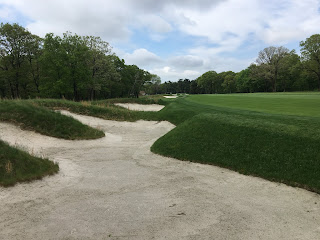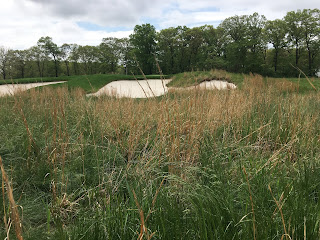First there's the length. Bethpage Black stretches out to almost 7,500 yards and when I was done playing it felt more like 10,000 yards. Six of the par-4s are more 475 yards long and can play longer in the wind. Bethpage is a big, bad, brute, and playing it can be an absolute battle.
The main thing you have to do to play well (or in my case, survive) at Bethpage Black however is drive the ball well. Length helps if you have it. But if you're playing this course from anywhere other than the fairway, you're going to be in for a long day.
And Black becomes its most cold-blooded and defiant on the final six holes. There's an incredible variety of challenges, types of shots you have to hit, elevation changes, and wind adjustments that need to be made. Black throws it all at you like a heavyweight in the final round needing a knockout to win the fight. Let's move on to my hole-by-hole detailed course review of Bethpage Black: The Back-9.
HOLE NO. 10
Par-4, 502 Yards
The back-9 begins with a pretty straightaway hole, but that doesn't mean it's not dangerous. Hazards on both sides of the fairway require two straight flying shots to reach the green safely.
Drives that miss left will find tall fescue, bunkers, or grass hollows. Misses right will be imprisoned by trees. A unique feature of this hole is also a dangerous one, a 50-yard stretch of rough that separates the end of the fairway from the green.
The green is elevated and protected by bunkers and fescue tough, and can be extremely difficult to hold (especially when the hole plays downwind). Miss over the green and a collection area in the back is a tough up-and-down.
HOLE NO. 11
Par-4, 435 Yards
For the second consecutive hole, the fairway is bordered by eight irregular-shaped bunkers, and misfired drives can again easily find the gargantuan finger bunkers and towering fescue rough.
Your drive is extremely intimidating as no part of the fairway is visible from the tee. and the landing zone narrows the farther you hit your ball.
The green is devilishly sloped from back to front and anything hit above the hole will leave you with a perilously quick putt. A false front can funnel your approach into either of the left or right bunkers at the opening of the putting surface.
HOLE NO. 12
Par-4, 501 Yards If you can carry the "V-shaped" glacier bunker that juts into the fairway from the left on this dogleg hole, you'll have a favorable angle and shorter distance into the green. It's a tough bunker to clear however, especially with prevailing winds.
Your other option is hitting to the right fairway, but too far right and you'll bring an outside corner bunker into play on that side, and you'll have a much longer approach (up to a 3-club difference).
The green is pretty large with significant undulations and slopes severely from back to front. The putting surface is two-tiered, so hitting the the right spot on approach could be the difference between a makeable putt and just a lag putt.
HOLE NO. 13
Par-5, 608 Yards This is the only par-5 on the back nine, and it's a long one. It also has one of the narrowest fairways on the course, so you have that going for you too. Standing on the tee it amazed me that Tiger reached in two in the 2002 U.S. Open with driver and 2-iron. It amazed me even more after I hit my drive.
Two large fairway bunkers on the left side are brutal if you find them (which of course I did). And for anyone who lays up (which will be most everyone who doesn't have a Tour card), there’s a puzzle-piece bunker 120 yards out.
For good measure, a punishing cross-bunker about 30 yards short of the green that will capture mishit approaches. And the table-top green is protected on the right side by one of the deepest bunkers on the course.
HOLE NO. 14
Par-3, 161 Yards This shortest hole on the course requires a delicate shot over a wispy grass valley to a green that's wider than it is deep, and slopes from back to front and right to left. It's an easy mid-iron shot if you're accurate. It's simply brutal if you misfire by even a hair.
The front bunkers are deep and menacing much like the famed 11th hole at St. Andrews, and a small false front on the left with a small false front on the left.
The green is two tiered with a back shelf, and anything long could roll off some 30 yards down into a collection area.
HOLE NO. 15
Par-4, 478 Yards Despite the wide open appearance from the tee and absence of fairway bunkers, this is a demanding and intimidating hole. Called the "corral hole," because of the rail fence along the right side, the fairway is lined by rough and fescue on both sides, and moves gently to the left but slopes to the right (reverse camber).
On approach it can almost feel like you're standing on the side of a hill, and the green sits a good 50 feet above the fairway, hence the nickname "heart attack hill." If you find either of the two cavernous bunkers protecting the front, it's another 10 feet up just to clear the lip, and your playing partners won't be able to see you.
The two-tiered green has a gentle back-to-front contour. And if you hit long heavy fescue rough behind the green is certain death. This is a hole that will make you wake up screaming in the middle of the night.
HOLE NO. 16
Par-4, 490 Yards
From an elevated tee and with no bunkers in sight, you're tempted to just bomb away. But if you flare your drive right, fescue, rough, and dense trees are waiting. It also creates a poor angle into a diagonal green that's protected on the short side by a huge bunker.
The wind usually plays in your face, and you're pretty much playing on the same slope down that you just played up on the previous hole.
The green is protected by a deep bunker on the left and a huge puzzle piece bunker on the right.
HOLE NO. 17
Par-3, 207 Yards
Five bunkers (two front, and one left, right, and back) pinch a wide, shallow green, and make it tough to see where the green starts and the sand ends.
The tee shot is uphill and the greens complex is more sand than putting surface.
A spine bisects the hourglass-shaped green creating two pronounced surface tiers.
HOLE NO. 18
Par-4, 411 Yards
The downhill tee shot is threatened by clusters of amoeba bunkers and fescue rough narrowing the landing area on both sides. The farther you hit your drive the more the fairway narrows and brings these hazards into play. You're going to have to make a decision to lay up short of the trouble, or attempt to thread your shot between or even past the hazards.
Whichever decision you make, if you can stay in the short grass you're going to get a pretty straightforward approach into a relatively small green with the clubhouse in the background.
The green sits uphill from the fairway and tilts diagonally. Two puzzle piece bunkers surrounded by fescue protect the green and can be trouble to escape.


















































No comments:
Post a Comment